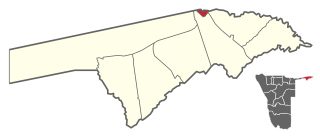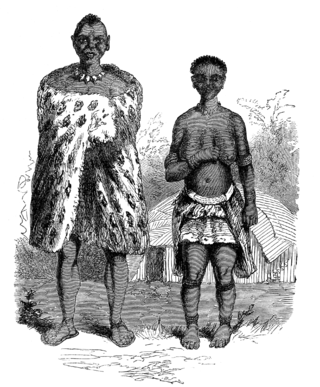The history of Namibia has passed through several distinct stages from being colonised in the late nineteenth century to Namibia's independence on 21 March 1990.

The Zambezi Region is one of the 14 regions of Namibia. It is located in the north-eastern part of the country. It is largely concurrent with the major Zambezi River after which it was named. The region has eight constituencies and its capital is the town of Katima Mulilo. The self-governed village of Bukalo is also situated in this region. The Zambezi Region had a population of 90,596 in 2011. As of 2020, it had 47,884 registered voters.

The Caprivi Strip, also known simply as Caprivi, is a geographic salient protruding from the northeastern corner of Namibia. It is bordered by Botswana to the south and Angola and Zambia to the north. Namibia, Botswana and Zambia meet at a single point at the eastern tip of the Strip, which also comes within 150 m (490 ft) of Zimbabwe thus nearly forming a quadripoint.

Katima Mulilo UrbanConstituency is an electoral district in Namibia. It is situated in the Zambezi Region. The region's capital, Katima Mulilo, is in this constituency. The constituency has a population of 28,362 people. In the 2020 Regional Council Elections, there were 13,860 registered voters.

Katima Mulilo Rural is a constituency in the Zambezi Region of Namibia. It comprises the area south of the town of Katima Mulilo, the regional capital. As of 2020, the constituency had 6,712 registered voters.
Katuutire Kaura was a Namibian politician. He was president of the Democratic Turnhalle Alliance (DTA) from 1998 to 2013 and was the official leader of the opposition from 2000 to 2005.

Katima Mulilo or simply Katima is the capital of the Zambezi Region in Namibia. It had 28,362 inhabitants in 2010, and comprises two electoral constituencies, Katima Mulilo Rural and Katima Mulilo Urban. It is located on the B8 national road on the banks of the Zambezi River in the Caprivi Strip in lush riverine vegetation with tropical birds and monkeys. The town receives annual average rainfall of 654 millimetres (25.7 in).

The Popular Democratic Movement (PDM), formerly the Democratic Turnhalle Alliance (DTA), is an amalgamation of political parties in Namibia, registered as one singular party for representation purposes. In coalition with the United Democratic Front, it formed the official opposition in Parliament until the parliamentary elections in 2009. The party currently holds 16 seats in the Namibian National Assembly and one seat in the Namibian National Council and is the official opposition. McHenry Venaani is president of the PDM.

Luhonono, until 2013 Schuckmannsburg, is a settlement in the Caprivi Strip in northeastern Namibia with a population of about 800. It belongs to the Kabbe North electoral constituency of the Zambezi Region. During the time of German colonialism, it was the capital of the Caprivi Strip.

Albert Mishake Muyongo is a Namibian politician and former Member of Parliament who is currently living in exile in Denmark.

Caprivi Liberation Army (CLA) is a Namibian rebel and separatist group which was established in 1994 to separate the Caprivi Strip, a region mainly inhabited by the Lozi people. It operates only in the Caprivi strip.

The MaYeyi are Bantu-speaking people of north-western Botswana and north-eastern Namibia. The Yeyi immigrated to the area in the 18th century from the north, and lived in close cooperation with the San people, or Basarwa, in particular, the Xanikhwe who had lived in the area previously. They speak ShiYeyi, a language that was influenced by the San and exhibits the characteristic clicks.
John Mabuku was the governor of Caprivi Region in Namibia and secessionist supporter of an independent Caprivi Strip. Mabuku, a former Democratic Turnhalle Alliance National Council member, fled to exile in Botswana with former DTA leader Mishake Muyongo following a failed separatist revolt in 1998 in the Caprivi Strip against the Namibian government.
The Caprivi treason trial is a trial in which the Government of Namibia indicted 132 people for allegedly participating in the Caprivi conflict on the side of the Caprivi Liberation Army during a period between 1992 and 2002. They were charged with high treason, murder, sedition, and many other offences, altogether 278 counts of criminal conduct.

The United Democratic Party (UDP) is a political party in Namibia, representing mainly people from Eastern Caprivi and advocating for the secession of the Caprivi Strip.
The Caprivi Vision is a weekly published community newspaper in Namibia with content in English and Lozi. It is sold in the Caprivi Strip now Zambezi Region, Northern Regions of Namibia, in the capital Windhoek and other countries of the Southern Africa such as Botswana and Zambia. The Caprivi Vision was founded by Risco Mashete Lumamezi on 21 August 2000 as a student of the Polytechnic of Namibia, and its first edition was sold in Katima Mulilo on 30 April 2002.
Richard Kapelwa Kabajani was a Namibian activist, militant, diplomat and politician. Kabajani was a military commander for SWAPO during the Namibian War of Independence and after independence served a minister in the Namibian government.

Bwabwata National Park is a protected area in northeastern Namibia that was established in 2007 and covers 6,274 km2 (2,422 sq mi). It was created by merging Namibia's Caprivi Game Park and Mahango Game Park. It is situated in the Zambezi and Kavango East regions, extending along the Caprivi Strip. It is bounded by the Okavango River to the west and the Kwando River to the east. Angola lies to the north and Botswana to the south.
Brendan Kongongolo Simbwaye (1934–1972?) was a Namibian anti-apartheid activist who was president of the Caprivi African National Union (CANU). Simbwaye became the vice-president of the South West Africa People's Organization (SWAPO) in 1964 after the two organizations merged. Simbwaye's life and political career was cut short in 1972 when he disappeared without trace.
Boniface Bebi was a Mamili, or tribal king, of the Mafwe in Namibia, from 1987 to 1999. Born in Linyanti, South West Africa, he succeeded Richard Muhinda in 1987, as the sixth recorded King of the Mafwe. After being involved in the Caprivi conflict, in which autonomy was sought for the Lozi people of the Caprivi Strip, he fled for Botswana, which granted him political asylum, after which Denmark granted him and Mishake Muyongo political asylum. His first-born child, Hoster Bebi, died in 2000; he lost a son while in Danish exile.













